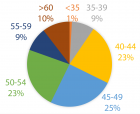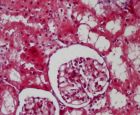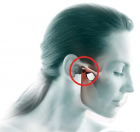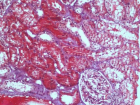About Istanbul University
Istanbul University
Articles by Istanbul University
Effects of carazolol on electrocadiographic and trace element status in sheeps
Published on: 9th April, 2018
OCLC Number/Unique Identifier: 7666282308
Carazolol is a non-specific β-adrenargic reseptor blocking agent. It ıs structurally analogous to catecholamins, in that, when administered, it forms reversible bonds with β-adrenergic, however, induce adrenergic effects, and it inhibits the actions of the catecholamins in times of stres by saturing their sites of operation. The purpose of the research was to investigate the effects of carazolol on some serum enzymes, trace elements and cardiovascular status in sheep. Seven sheeps (age 6 months, 35 ± 10 kg) were used in this study. Carazolol administered by the intramuscular route at the dose of 0.01 mg/kg. Serum levels of urea, creatinin, ALT, AST, G-GT, LDH, T. protein, Ca, P, Mg, Cu, Fe, Zn, Se were investigated. Although all serum enzymes did not show any difference, serum Fe and Zn levels were decreased. Important results were obtained in electrocardiography (abnormal T wave and ST segment depression).
These results suggest that carazolol may increase incidence rate of myocardiyal ischemia risk in sheeps and it investigated by new researches.
A great mimicker of Bone Secondaries: Brown Tumors, presenting with a Degenerative Lumber Disc like pain
Published on: 17th July, 2017
OCLC Number/Unique Identifier: 7317646408
This report presents an adult patient suffering from sacroiliitis like low back pain, lumbosacral radiculopathy and elbow swelling. Multimodality imaging revealed multiple lytic bone lesions located in supra acetabular iliac bone, sacrum, and distal end of radius. Painful numerous lesions due to the extension to the articular surfaces are not expected for Brown tumors. Less than ten cases with multiple Brown tumor due to primary hyperparathyroidism has been reported. Although Brown tumors are mostly diagnosed incidentally, this case would awake the physicians about rheumatological symptoms in the presentation of Brown tumors. Since Brown tumors are non-touch bone lesions that are expected to regress after parathyroid adenoma removal, it is important to distinguish Brown tumors from the giant cell tumors.
Nasopalatin duct cysts: Report of ten cases and review of literature
Published on: 10th November, 2020
OCLC Number/Unique Identifier: 8872658282
Nasopalatine duct cyst is the most common non-odontogenic cyst. It develops in the midline of the anterior maxilla. It is usually asymptomatic and sometimes it can be overlooked or misdiagnosed. We present 10 patients who applied to Istanbul University Faculty of Dentistry, Department of Oral and Maxillofacial Surgery.
Clinical evaluation of the eye-to-visual-pathway integrity of glaucomatous neurodegeneration using 1.5T MR imaging: The integrity of glaucomatous neurodegeneration
Published on: 9th March, 2022
Aim: Accumulating data imply that glaucoma may represent a neurodegenerative disorder affecting the entire visual system. We evaluated retrobulbar glaucomatous damage with favorable techniques for 1.5T diffusion-tensor magnetic resonance imaging and we compared those techniques with clinical data in a large case series. Material and methods: This Cross-sectional study included 130 eyes of 65 patients with primary open-angle glaucoma. Patients with no known ocular or systemic concomitant disorders, neurological diseases, previous glaucoma surgeries, or antioxidant usage were selected. A decrease in thickness and deterioration in the optic nerve diffusion of severely glaucomatous eyes of patients with asymmetrical involvement was observed in optic nerve tractography. Optical coherence tomography and visual field results of the subjects were recorded. Glaucoma analysis with optical coherence tomography and standard automated perimetry results of the subjects were recorded. Diffusion-tensor magnetic resonance imaging analysis of optic nerves and radiations were performed, computing fractional anisotropy, apparent diffusion coefficient, axial diffusivity, and radial diffusivity. Correlation between the diffusion-tensor magnetic resonance imaging and clinical eye parameters of glaucomatous neurodegeneration were statistically evaluated. Results: The correlations between diffusion parameters and age were highly significant. Statistically significant correlations were found between ganglion cell complex and apparent diffusion coefficient, axial and radial diffusivities of optic nerves. Conclusion: Eye-brain connection in glaucoma can be evaluated with routine clinical instruments. Our study also revealed a limited correlation of retrobulbar glaucomatous neurodegeneration with ophthalmic damage. A better understanding of retrobulbar damage will enable us to develop more efficient strategies and a more accurate understanding of glaucoma.
Idiopathic progressive polyneuropathy presented with frequently acute pulmonary oedema: a case report
Published on: 29th September, 2022
Neuropathy is when nerve damage interferes with the functioning of the peripheral nervous system (PNS). When the cause can’t be determined, it’s called idiopathic neuropathy(Idiopathic neuropathy, now designated as chronic idiopathic axonal polyneuropathy (CIAP).There are three kinds of nerves within the PNS. Sensory nerves relay messages from the sense organs to the brain. This allows sensations of temperature and touch. Motor nerves transmit signals from the brain to the muscles. This helps the brain control the muscles. Autonomic nerves control body functions like heart rate, breathing, and digestion.Damage to nerve cells can affect how the PNS communicates with the rest of the body. Symptoms can include numbness, pain, and balance issues.It’s called acute neuropathy when symptoms develop suddenly. Alternately, it’s called chronic neuropathy when symptoms start slowly and increase over time. Diagnosis involves physical examination and review of medical history. Diagnostic testing may include blood tests, nerve testing, and imaging tests.There is no cure for idiopathic neuropathy. Treatments including medication, physical therapy, and lifestyle modifications can help you function and feel better.We report a case of idiopathic polyneuropathy presented with frequent acute pulmonary edema for a year.

HSPI: We're glad you're here. Please click "create a new Query" if you are a new visitor to our website and need further information from us.
If you are already a member of our network and need to keep track of any developments regarding a question you have already submitted, click "take me to my Query."


















































































































































